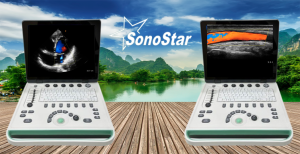Portable Color Doppler Ultrasound: A Revolutionary Tool in OB/GYN Care

Contact: 01717811312
The evolution of ultrasound technology has transformed obstetrics and gynecology (OB/GYN), enabling healthcare professionals to diagnose, monitor, and treat patients with unprecedented precision and efficiency. Among the latest advancements is the portable color Doppler ultrasound, a compact and highly versatile device that combines portability with the power of Doppler imaging. This article explores the applications, benefits, and future potential of portable color Doppler ultrasound in OB/GYN care.
What is a Portable Color Doppler Ultrasound?
A portable color Doppler ultrasound is a compact diagnostic tool that integrates traditional grayscale ultrasound with Doppler technology. It visualizes the flow of blood within vessels and organs in real-time using color overlays, enhancing diagnostic capabilities. Unlike traditional cart-based systems, portable models are lightweight, battery-operated, and often wireless, making them ideal for point-of-care use.
How Doppler Ultrasound Works
Doppler ultrasound measures the change in frequency of sound waves as they bounce off moving blood cells. This principle, known as the Doppler effect, allows the device to calculate the speed and direction of blood flow.
- Color Doppler: Provides a color-coded map of blood flow, indicating direction and velocity.
- Power Doppler: Highlights even low-velocity blood flow for better sensitivity.
- Spectral Doppler: Offers detailed graphs of blood flow patterns for quantitative analysis.
Applications in OB/GYN Care
1. Pregnancy Monitoring
Portable color Doppler ultrasound is indispensable for monitoring pregnancies, ensuring maternal and fetal well-being.
- Fetal Heartbeat Assessment: Detects fetal heart rate and rhythm early in pregnancy, aiding in the detection of anomalies.
- Placental Health Evaluation: Assesses placental blood flow to detect insufficiency or abnormalities like placenta previa.
- Fetal Growth Tracking: Measures parameters such as biparietal diameter, femur length, and abdominal circumference.
- Multiple Pregnancy Monitoring: Evaluates twin-to-twin transfusion syndrome by visualizing umbilical cord blood flow.
2. High-Risk Pregnancy Management
High-risk pregnancies demand meticulous monitoring, and portable Doppler devices make it possible even in remote or resource-limited settings.
- Preeclampsia Screening: Measures uterine artery resistance to predict and manage preeclampsia.
- Intrauterine Growth Restriction (IUGR): Tracks blood flow in the umbilical artery and middle cerebral artery to detect fetal growth restrictions.
- Amniotic Fluid Assessment: Visualizes amniotic fluid levels and abnormalities such as oligohydramnios and polyhydramnios.
3. Diagnosing Fetal Anomalies
Portable Doppler ultrasound enhances the detection of fetal anomalies, allowing for early interventions.
- Congenital Heart Defects: Identifies structural and functional heart anomalies using detailed Doppler studies.
- Neural Tube Defects: Detects conditions such as spina bifida.
- Abdominal Wall Defects: Diagnoses gastroschisis and omphalocele by visualizing blood flow in affected areas.
4. Gynecological Applications
Portable color Doppler ultrasound plays a significant role in diagnosing and managing gynecological conditions.
- Ovarian Cysts and Masses: Differentiates between benign and malignant lesions based on blood flow patterns.
- Uterine Fibroids: Monitors the growth and vascularity of fibroids.
- Endometriosis: Identifies vascular patterns in endometriotic lesions.
- Pelvic Inflammatory Disease (PID): Detects complications such as abscesses or vascular changes.
5. Fertility Assessments and Assisted Reproductive Technology (ART)
Portable Doppler devices are invaluable in fertility clinics and ART procedures.
- Ovarian Follicle Monitoring: Tracks follicular growth during ovulation induction.
- Endometrial Receptivity Assessment: Evaluates uterine blood flow to predict implantation success.
- Guiding Oocyte Retrieval: Provides real-time imaging for precision during egg retrieval procedures.
6. Emergency OB/GYN Applications
In emergencies, portable ultrasound provides quick and accurate diagnoses, enabling timely interventions.
- Ectopic Pregnancy Detection: Identifies ectopic pregnancies through Doppler evaluation of vascular patterns.
- Postpartum Hemorrhage: Locates retained products of conception and evaluates uterine blood flow.
- Ruptured Ovarian Cysts: Assesses pelvic blood flow to detect bleeding.
Benefits of Portable Color Doppler Ultrasound in OB/GYN
- Portability: Lightweight and wireless models enable use in diverse settings, from clinics to rural areas.
- Real-Time Imaging: Provides immediate insights for rapid decision-making.
- Cost-Effective: Reduces the need for expensive cart-based systems.
- Accessibility: Expands access to advanced imaging in resource-limited settings.
- Telemedicine Integration: Facilitates remote consultations by transmitting images in real-time.
Key Features to Look for in a Portable Doppler Ultrasound for OB/GYN
- Image Quality: High-resolution imaging for accurate diagnosis.
- Doppler Modes: Availability of color, power, and spectral Doppler.
- Battery Life: Long-lasting batteries for uninterrupted use.
- Connectivity: Wireless capabilities for easy data sharing.
- Ergonomics: Compact design for ease of handling.
Clinical Case Studies
Case 1: Remote Fetal Monitoring in Rural Areas
A midwife in a rural clinic used a portable Doppler ultrasound to monitor a high-risk pregnancy. By detecting reduced blood flow in the umbilical artery, she referred the patient to a hospital for timely intervention, preventing fetal distress.
Case 2: Diagnosing Ectopic Pregnancy in an ER
An emergency physician used a portable Doppler device to identify a ruptured ectopic pregnancy in a patient presenting with acute abdominal pain. This rapid diagnosis enabled immediate surgical management.
Challenges and Limitations
- Operator Dependency: Accurate interpretation requires trained professionals.
- Limited Imaging Depth: Smaller devices may not penetrate deep tissues effectively.
- Battery Dependence: Prolonged use in busy settings may require frequent recharging.
Future of Portable Doppler Ultrasound in OB/GYN
The future of portable Doppler ultrasound is bright, with advancements in artificial intelligence (AI) and machine learning. AI-powered devices will enhance diagnostic accuracy by automatically identifying anomalies and predicting outcomes. Additionally, the integration of 5G technology will revolutionize telemedicine, enabling seamless image sharing and remote consultations.
Conclusion
Portable color Doppler ultrasound has revolutionized OB/GYN care by providing real-time, accessible, and accurate imaging. Its versatility in applications ranging from routine pregnancy monitoring to emergency interventions underscores its importance in modern healthcare. As technology continues to advance, these devices will further improve maternal and fetal outcomes, making quality OB/GYN care accessible to all.
